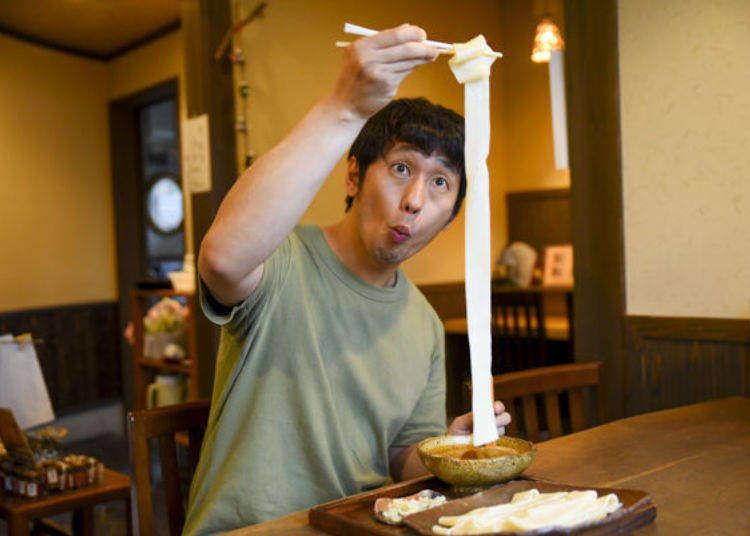
You may know udon, the thick Japanese noodles with the characteristic bite. There’s another such doughy delight, waiting to be discovered by Japanese noodle fans—meet himokawa udon, a specialty from the Kiryu area in Gunma Prefecture! This unique genre of Japanese noodles is characterized by each noodle having a width of up to 10 centimeters. Recently, himokawa udon have caused a boom in Japanese social media, so we set out to explore their taste, shape, and history at two local specialty restaurants!
Famous Overnight: The Gourmet Himokawa Udon Boom
Speaking of Gunma’s local gourmet specialties, most Japanese people will tell you about yaki-manju (grilled buns) and mizusawa udon, yet another udon variety. Shimonita negi (bunching onion) and konnyaku (konjac potato) come up as famous Gunma ingredients. However, the media has started to focus primarily on the less well-known himokawa udon in recent years, with gourmets constantly praising the dish from Gunma’s Kiryu area.
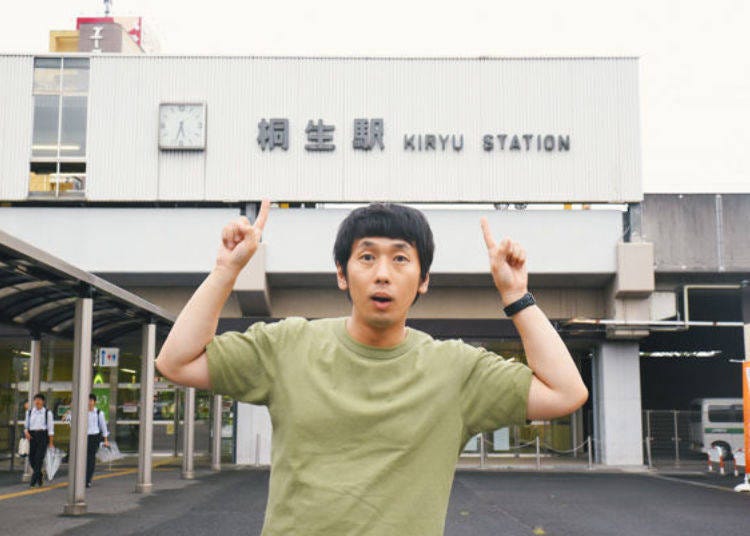
The characteristic of himokawa udon is that there is such a wide variety of noodles. Their size varies by shop, but most are over 10cm in width. Regular udon are only about 4mm thick, so you can imagine how ridiculously wide these himokawa udon are!
On the other hand, these udon are very thin, often not more than 1mm, and that makes for an interesting texture experience. Without further ado, let’s try this noodle specialty for ourselves! For that, we visit two extremely popular restaurants: Mendokoro Sakedokoro Furukawa and Fujiya Honten.
12cm Wide! Tasting Himokawa Udon at Furukawa
First, we’ll head to Furukawa. The popular restaurant has two locations, one at Park Inn Kiryu and one called Furukawa Kuremutsu. This time, we decided to go to Furukawa Kuremutsu and its rich menu. Taking the train, we transfer at Kiryu Station and go to Aioi Station via Watarasekeikoku Tetsudo. From there, it’s a 5-minute walk to the restaurant.
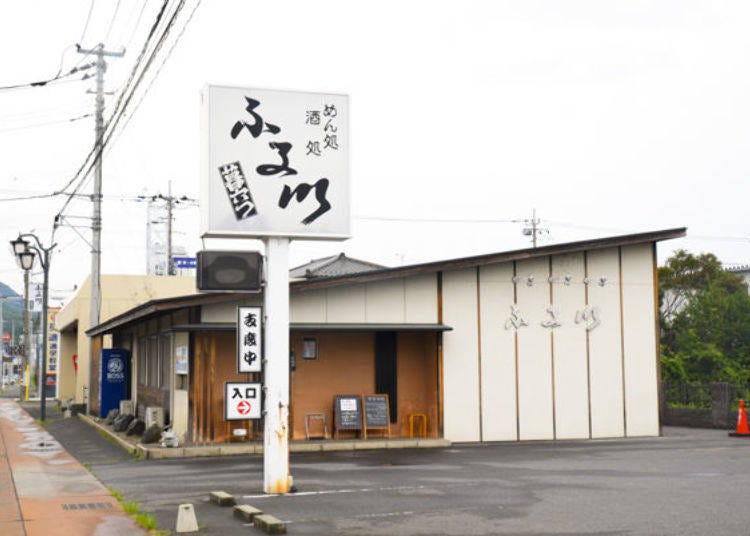
Furukawa was founded in 1972 as a roadside izakaya. It doesn’t only have a variety of noodle specialties on the menu but also plenty of side dishes and appetizers. It’s crowded with locals who stop by the place for a relaxed drink and snack. Of course, Furukawa’s specialty is different himokawa udon, ranging in width from 10 to 12cm. They fill your mouth with an overwhelming presence of noodly goodness and from the first bite on, it’s obvious that these dishes are positively addicting.
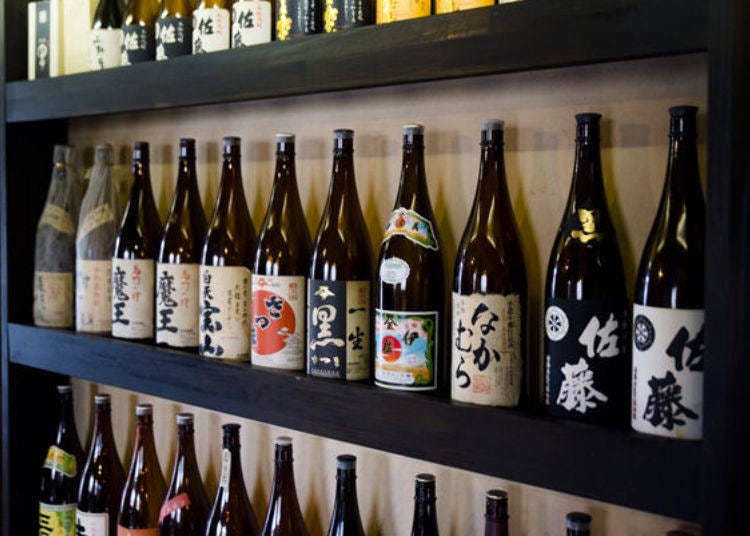
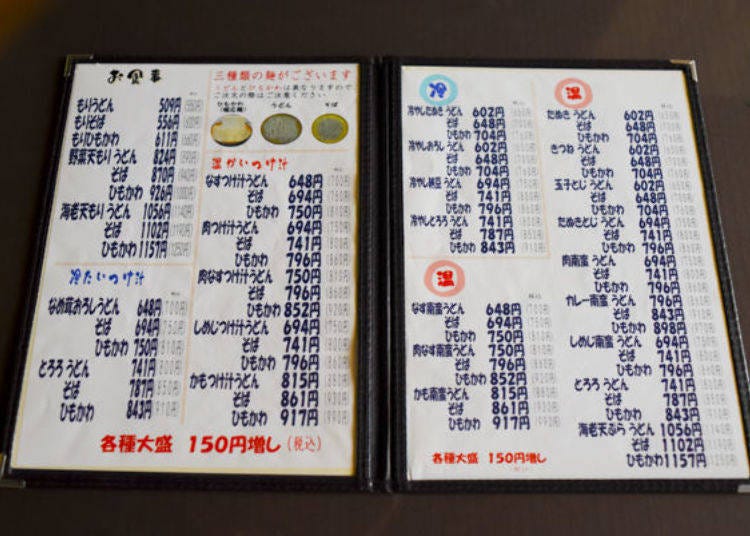
Tasting the Udon: Pleasantly Chewy, Wonderfully Flavorful, and Thoroughly Unique!
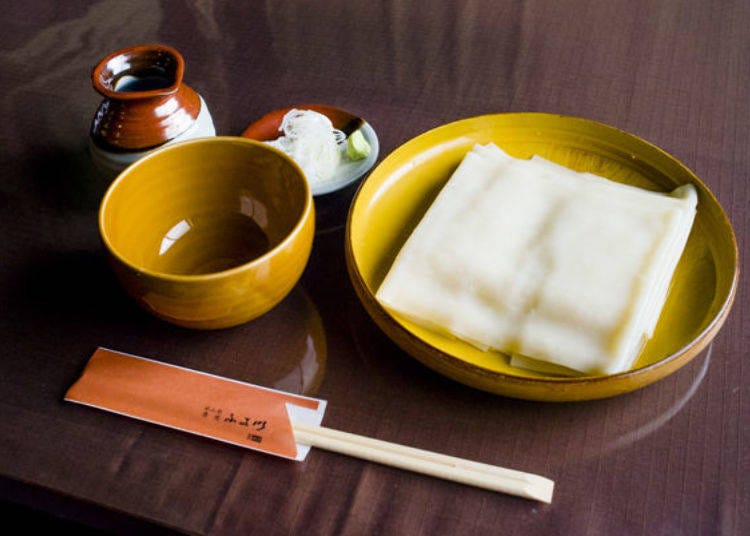
We immediately order the shop’s most popular menu item, “Mori Himokawa,” for 660 yen (tax included). While 12cm sounds wide, these noodles are far larger than we imagined, and they seem to have very little in common with regular udon. The himokawa udon certainly look impressive. But how is the taste?
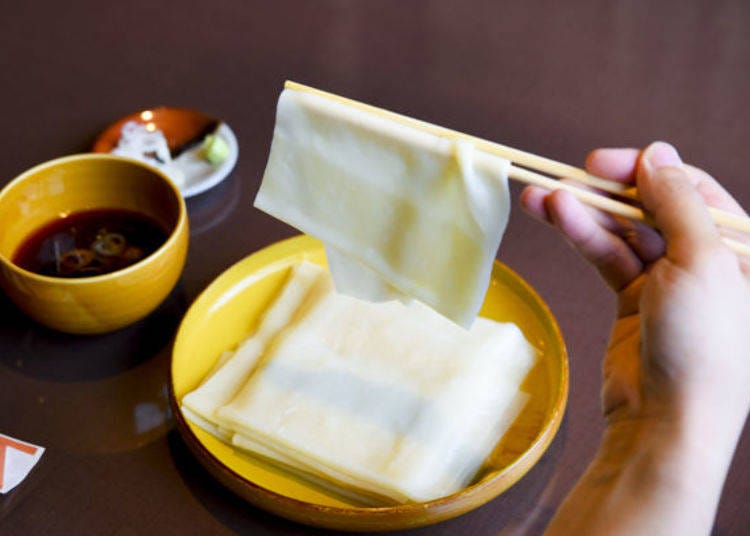
Our taste-tester picks up one noodle and is surprised by how heavy it is. It might be the first time that he had to actually put strength into lifting a piece of food!
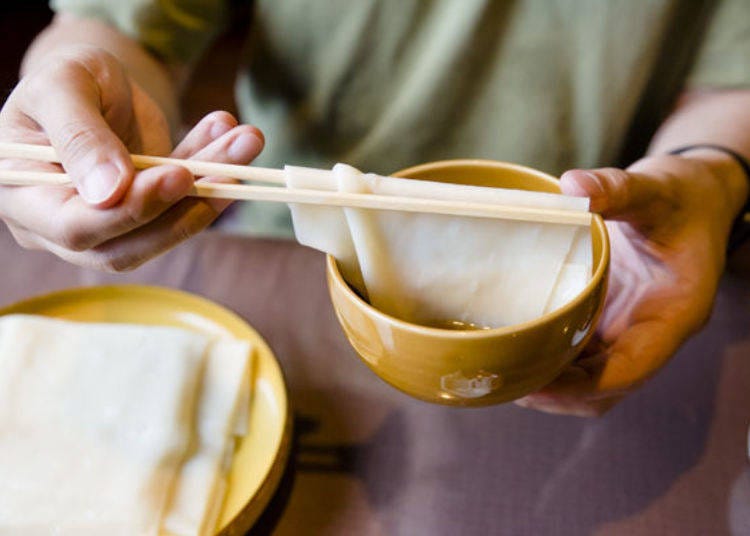
Of course, Tatsuya dips them in tsuyu sauce.
The first struggle is how to eat the himokawa udon—they’re extremely large, after all. We asked Furukawa’s shopkeeper about how to eat them, but according to him, there’s no official way and everyone does it differently. He gave us some advice, though: don’t forcibly try to eat it in one bite, but feel free to cut it with your chopsticks.
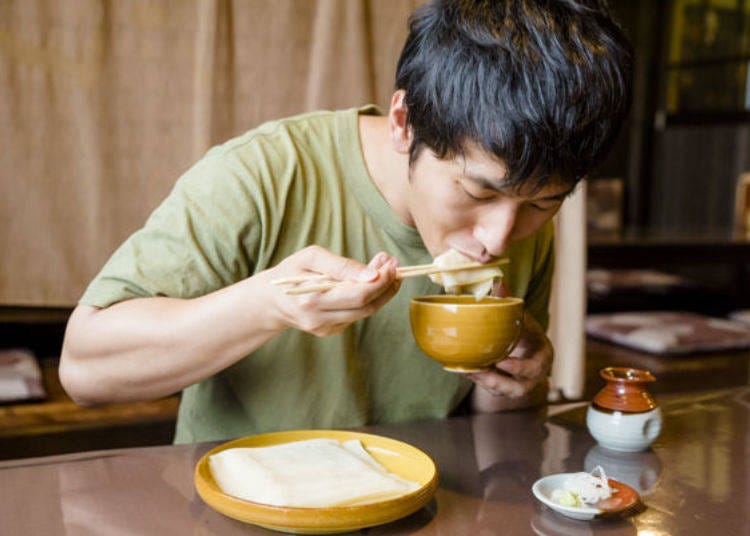
The noodle sheets are thin, though, so you easily can bite off a bit as well, letting you slurp in the flavorful delicacy. The taste itself is quite refreshing and the natural flavor of the pasta dough is nicely complemented by the bonito dipping sauce.
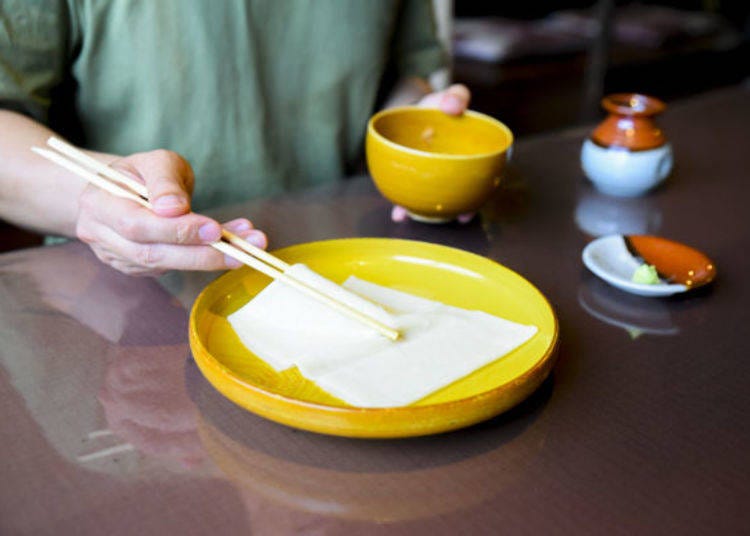
The noodles are thin, but they don’t fall apart when you lift them with your chopsticks. This elasticity is probably what makes the texture so interesting!
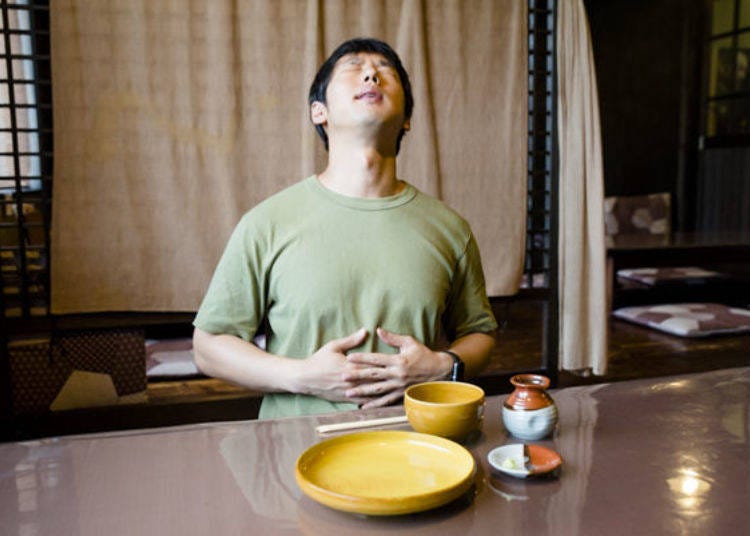
They’re gone in no time! These noodles are called udon, but it is hard to believe that thickness and width makes such a massive difference in regard to texture. They’re pleasantly chewy and slippery on the tongue, it’s definitely a one-of-a-kind experience.
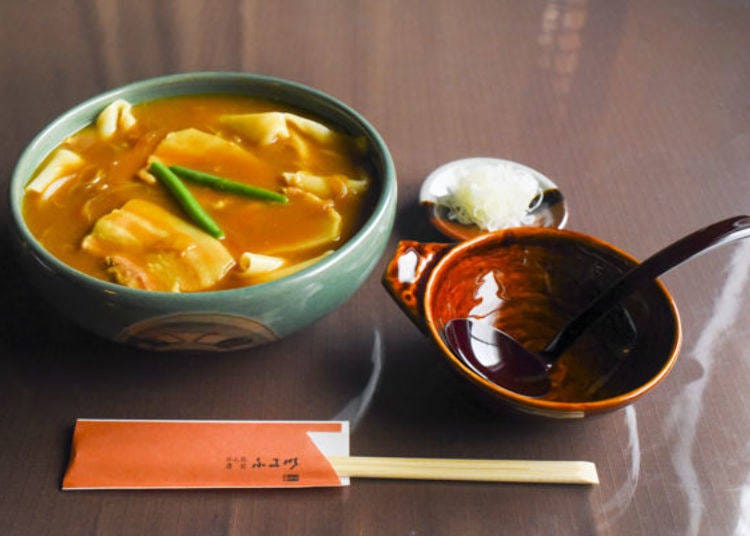
Another popular dish is the warm specialty called “Curry Nanban Himokawa” for 970 yen (tax included). It features a lot of big chunks of pork!
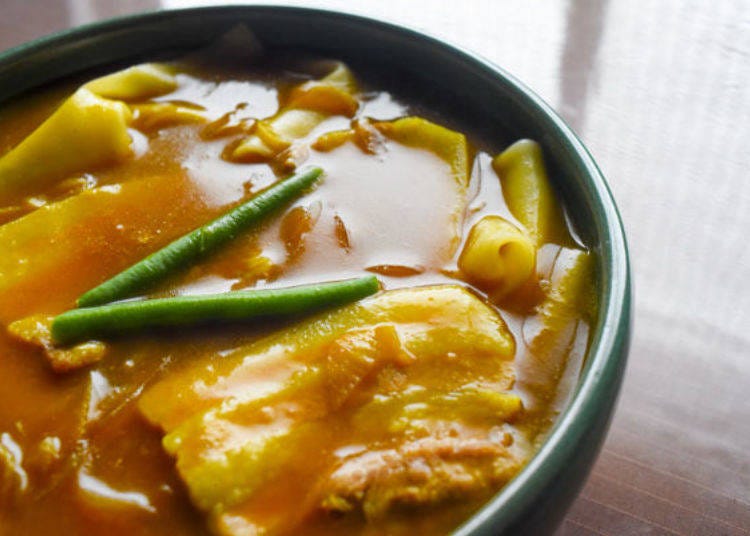
Originally, himokawa udon were a dish for the cold season. That’s why the hot curry version is so popular with Furukawa’s customers in autumn and winter, while the cold Mori Himokawa, which we had earlier, are more popular in summer.
Our taste-tester tries one spoonful of soup and is immediately taken by the rich taste! What’s unique about this shop’s curry is that it is infused with bonito broth, giving it a very subtle sweetness that helps to warm your body to the core.

Next up is the noodles. Because they’re so large, plenty of soups sticks to them, making for a proper mouth full of flavor!

While the texture is the same as the noodles’ cold version, the mouthfeel is completely different. The himokawa udon are even more firm to the bite when warm but also more elastic, just like rice cakes. However, they’re not sticky and swallowing is nice and smooth.
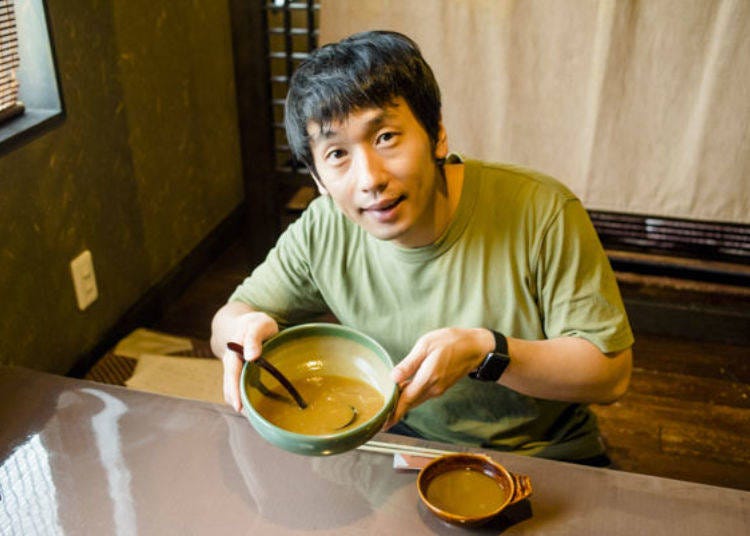
Made with Flour from Gunma Prefecture! The History of Himokawa udon is Older than Expected
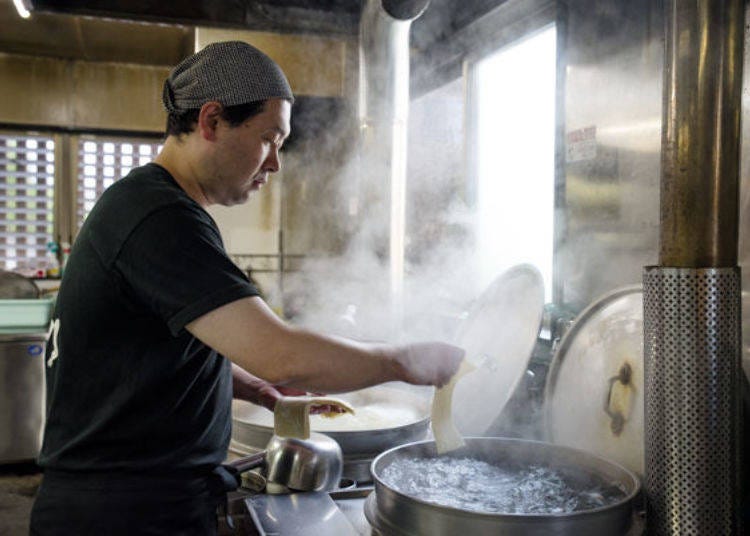
We were also invited to see how himokawa udon are boiled in Furukawa’s kitchen, This is Mr. Furukawa, third-generation shopkeeper who is cooking the noodles himself.
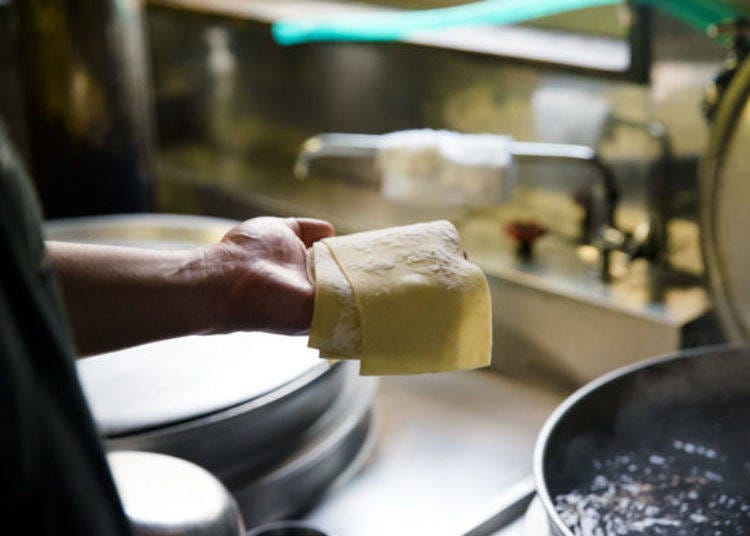
Just like regular udon, this variety is made out of the basic ingredients if water, flour, and salt. Furukawa uses local flour from Gunma Prefecture. They’re about 2mm thick, which isn’t too thick nor too thin.
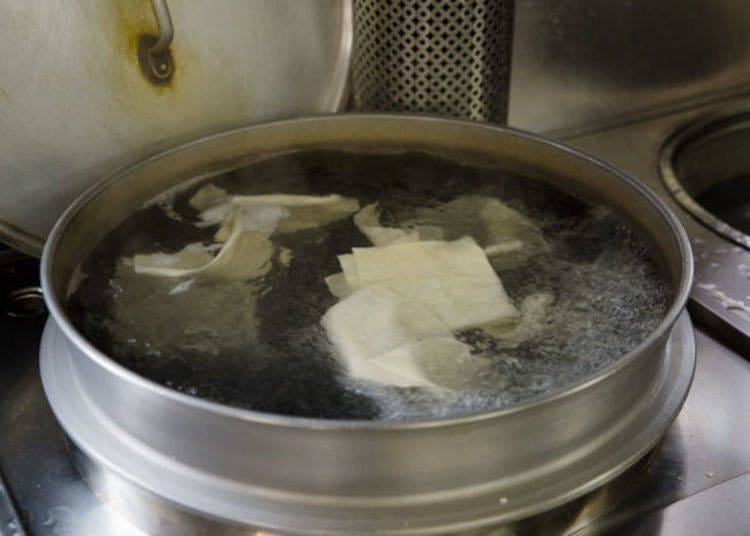
The cooking time is somewhat shorter with only 5 to 6 minutes. After that, they’re rinsed and put into ice water to harden them.

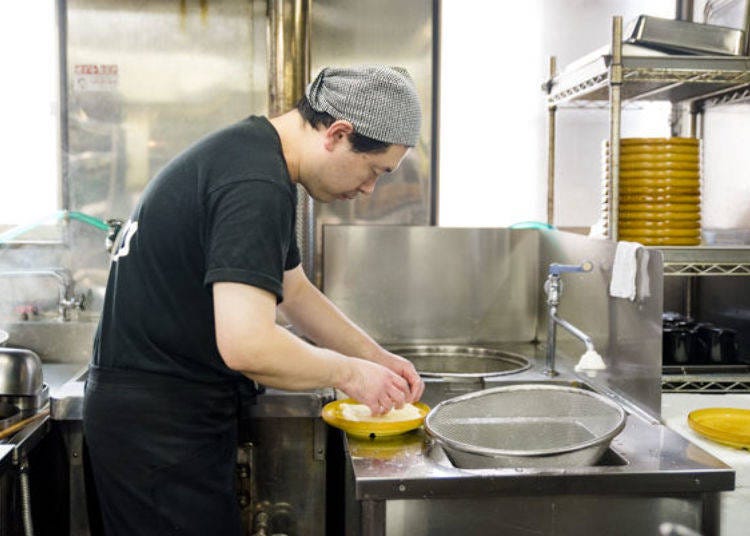
But since when did the people of Gunma’s Kiryu area start to enjoy this noodle specialty? We also asked Mr. Furukawa about himokawa udon’s sudden spike in popularity.
Mr. Furukawa: “There are no clear records, but it seems like himokawa udon have been around for about 100 years. It is said that the name has come from Aichi Prefecture’s udon from the Imokawa area. The name ‘Imokawa’ got stuck and turned into ‘himokawa.’”
Silk goods has been a major industry for Kiryu City in the past. The women working in these weaving factories were so busy, they had barely time to eat. In response to that, the large udon varieties were made, enjoyed in a few minutes. From there, they spread and became a local specialty.
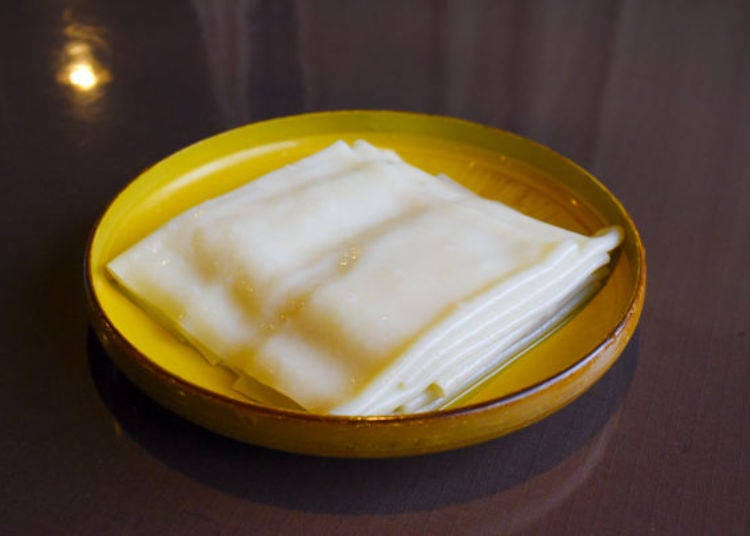
Mr. Furukawa: “In 2010, the ‘Himitsu no Kenmin Show’ showcased our shop’s himokawa udon on TV. We became famous overnight, with a massive queue of people lining up in front of the shop after the day of the broadcast. That was amazing.”
It’s interesting how a 100-year old local specialty, barely known outside the area, has become a nationwide phenomenon from one day to another, thanks to TV. The photogenic appearance of the noodles makes them a great dish for social media.
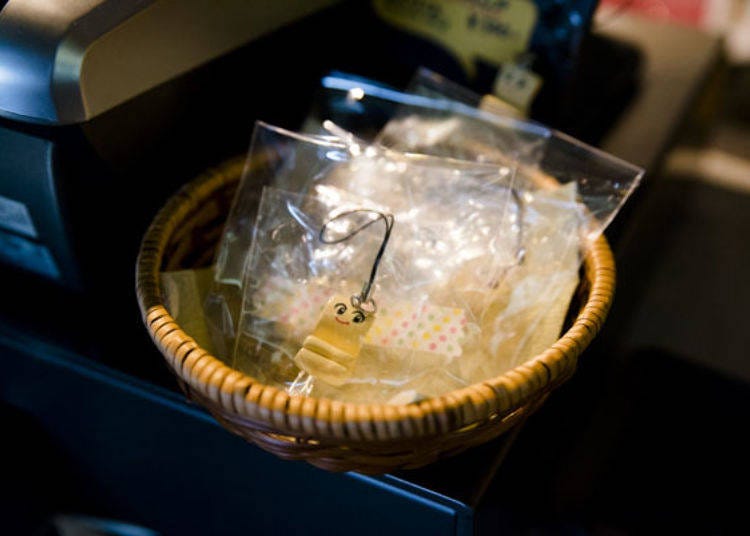
On the weekends, the shop has many guests from outside the prefecture. Sometimes, people even line up outside before opening during lunchtime. It is similarly crowded on weekdays during Golden Week and the Kiryu Yagibushi Matsuri festival in early August, as well as during Obon. Don’t let that discourage you, though, because Mendokoro Sakedokoro Furukawa’s himokawa udon are an absolutely must-have gourmet experience!
-
Mendokoro Sakedokoro Furukawa Kuremutsuめん処 酒処 ふる川 暮六つ桐生店
- Address 2-735-15 Aioichō, Kiryū-shi, Gunma-ken 376-0011
- Phone Number 0277-47-8190
Hours: 11:00 a.m. – 2:00 p.m. last order, 5:30 p.m. – 11:30 p.m. last order
Closed: Mondays (open in case of national holidays, closed on the following Tuesday)
Unbelievable: Fujiya Honden’s 60cm-Long Udon Noodles!
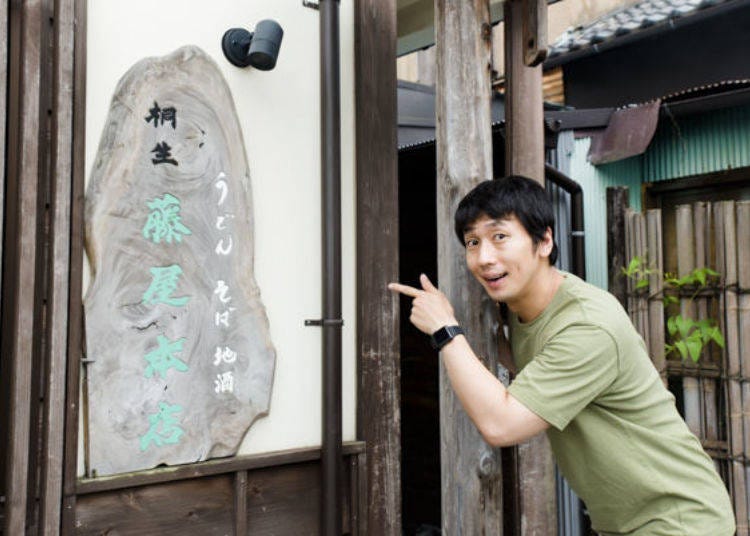
Next up is Fujiya Honden, a restaurant that is just as famous and popular as Furukawa. It’s a long-established store that boasts a history of over 120 years, delighting diners with dishes made with local water and local flour. It’s one station away from Kiryu Station and another 20 minutes of walking, but the scenic streets really just add to the atmosphere and enhances your gourmet experience as a whole.
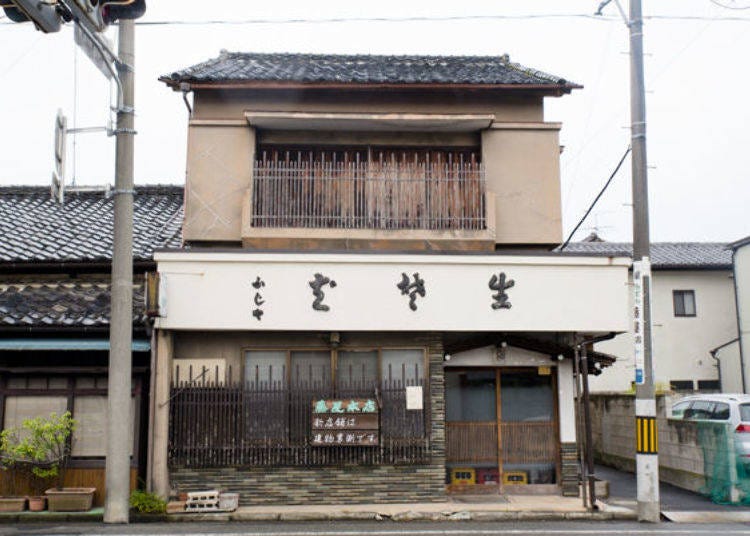
The current store is all new, but the old store is in the immediate vicinity, shown in the picture above. The old store is on the main street called Honcho-dori Street, and if you come from Kiryu Station, you can see the new shop as soon as you turn right at the intersection in front of the old shop.
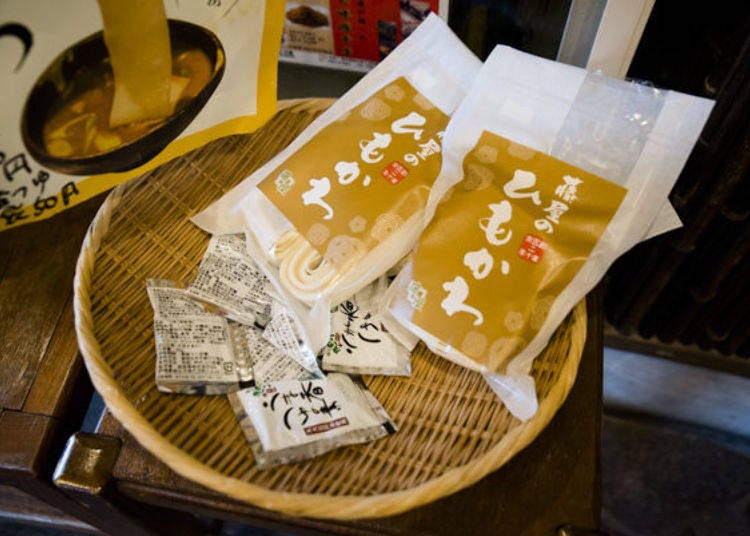
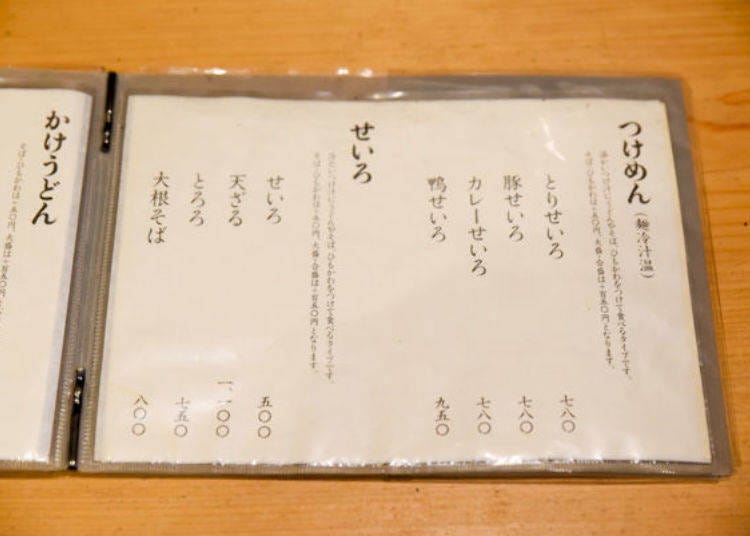
The udon menu is divided into tsukemen (noodles that are dipped into a soup or sauce), seiro (steaming baskets), and <kakeudon|i@> (udon in broth). The list of ingredients for each of those categories is also abundant. For an extra 50 yen, you can also change the udon of each dish to himokawa udon or soba.
Fujiya Honten’s Noodles Are Not Just Wide But Really Long!
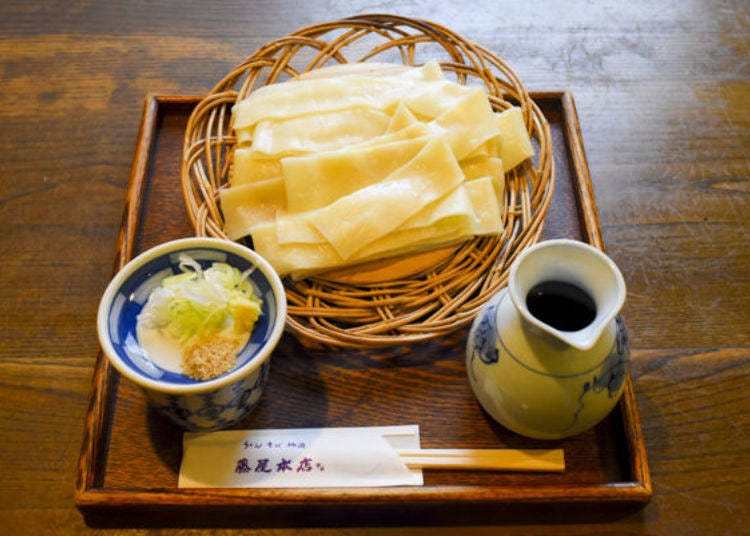
We ordered the popular “Himokawa Seiro” for 550 yen (tax included). Fujiya Honten’s himokawa udon are 4cm wide. That is quite a different style of noodles, compared to the 10cm noodles we enjoyed at Furukawa.
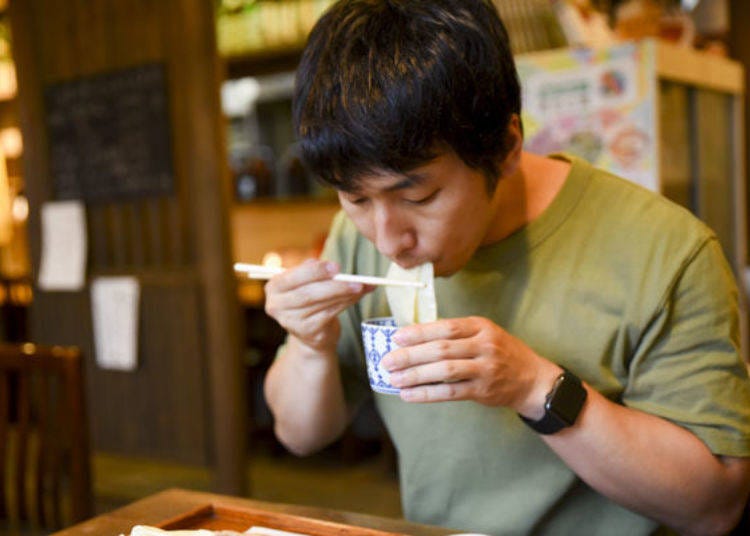
Again, our taste tester is surprised—the texture is quite different, even though nothing changed except the width! Fujiya’s udon have a wonderful bite, possibly because they’re somewhat thicker. They also boast a pleasant elasticity.

And just like Furukawa’s himokawa udon, the mouthfeel is amazing. They smoothly glide down the throat, and there’s a sensation of the stomach getting filled little by little. The dipping sauce seems light, but a wonderful bonito aroma unfolds with the first bite. This is an amazing gourmet experience!

Another popular dish at Fujiya is “Curry Seiro” for 830 yen (tax included). We are told that this dish was originally limited to autumn and winter but was added to the regular menu after so many customers asked for it.
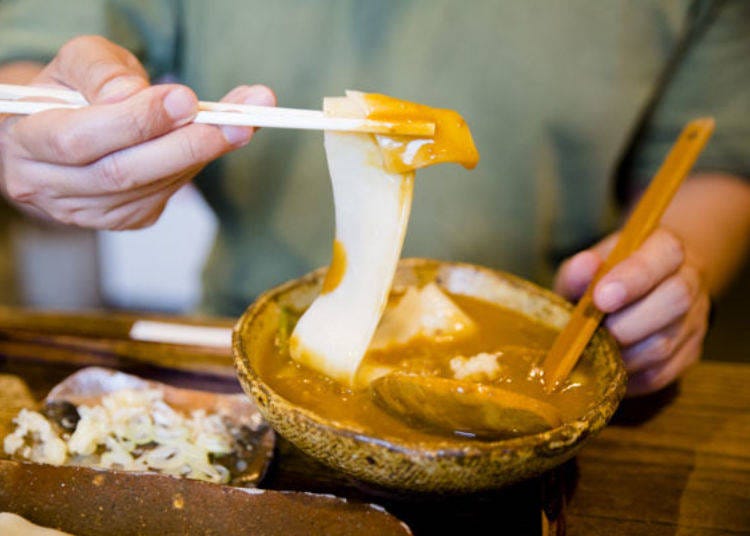
Tatsuya coats the udon with plenty of soup. With 4cm width, the himokawa udon are relatively narrow, but that allows you to slurp them! They’re also a bit easier to eat as you can fold them inside of your mouth.
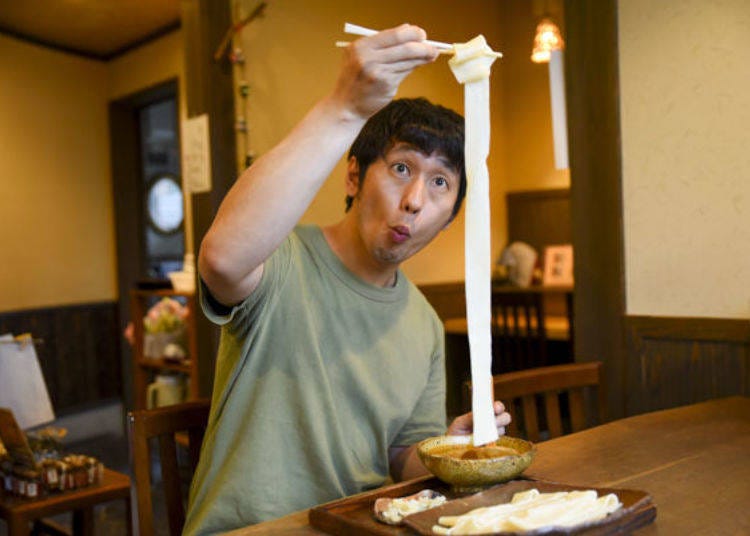
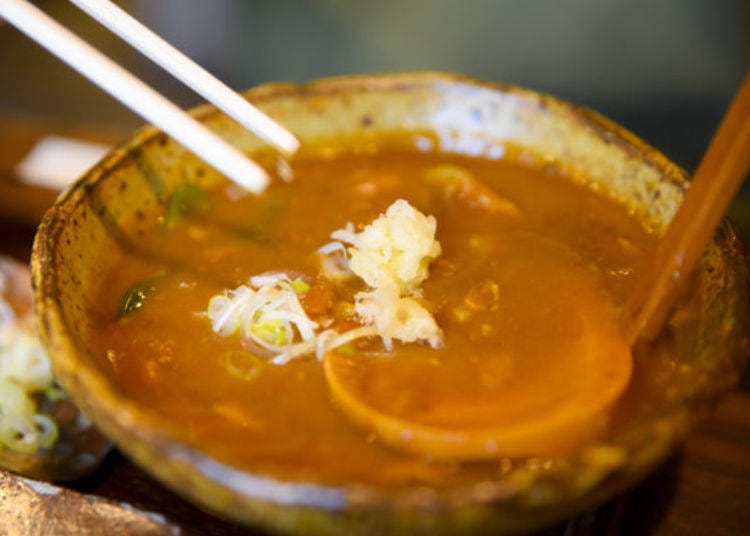
Rather than spicy, this is clearly a Japanese-style curry and feels like a soup. By dipping the udon into it, their unique flavor and texture are brought out wonderfully. Their firm-to-the-bite elasticity matches perfectly. The subtle sweetness of the curry paired with its pungency is also just the right flavor to go with the udon. Of course, Tatsuya ate every single noodle!
The Deliciousness of Local Ingredients!
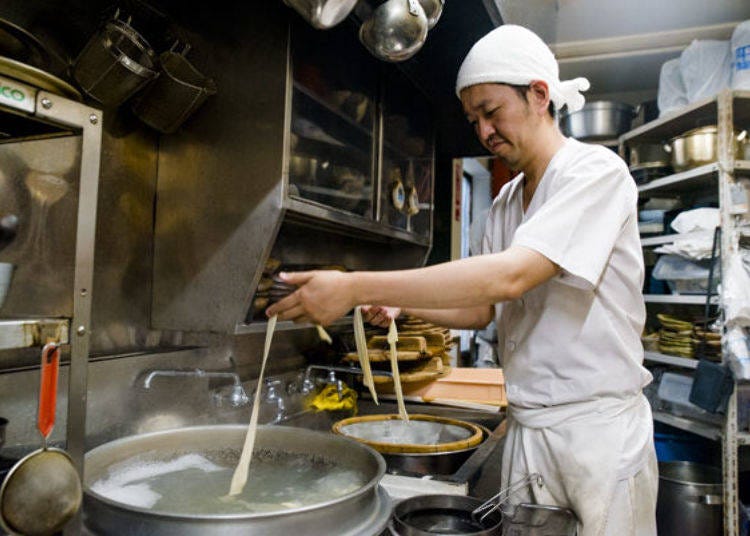
Here as well, we were invited to take a peek into the kitchen and we had a chance to see the noodles before being cooked. The chef is Mr. Masayuki Fujikake, 6th-generation shop owner.
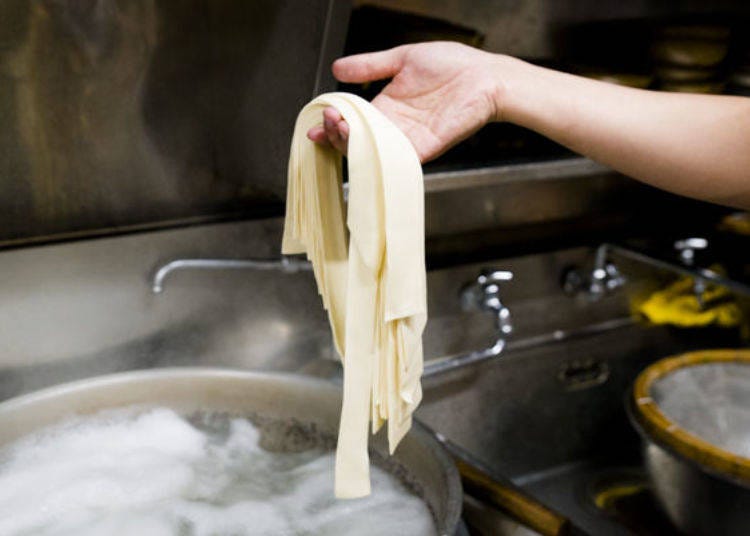
With a width of 4cm, Fujiya’s himokawa udon fall in the middle of the spectrum as far as the many varieties go. Their length is around 50 to 60cm and they weigh around 200g before being cooked. The finished dish is about 300g. “We decided on this width so that even women can eat them easily,” says. Mr. Fujikake. To retain the characteristic texture, the noodles were made longer to make up for the relatively slender width.
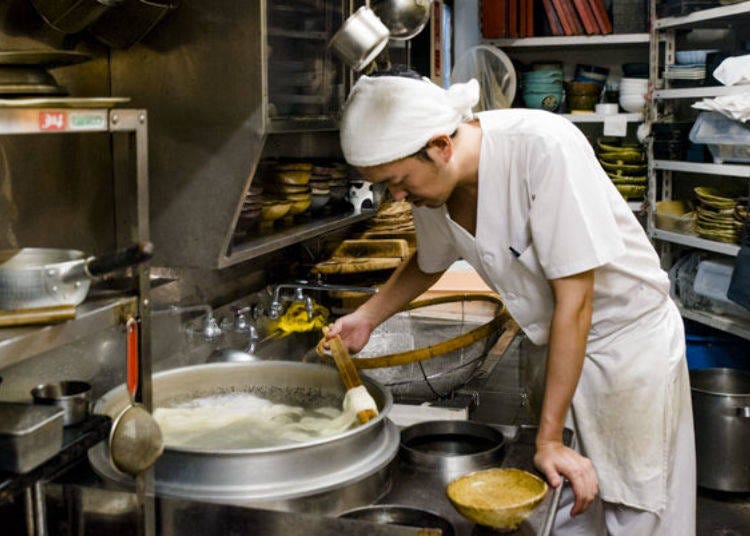

Mr. Fujikake is 36 years old (as of 2018) and trained at a restaurant in Tokyo for four years. At 28, he returned to his hometown to take over the store. Fujiya itself is over 120 years old, so when did it start to offer himokawa udon?
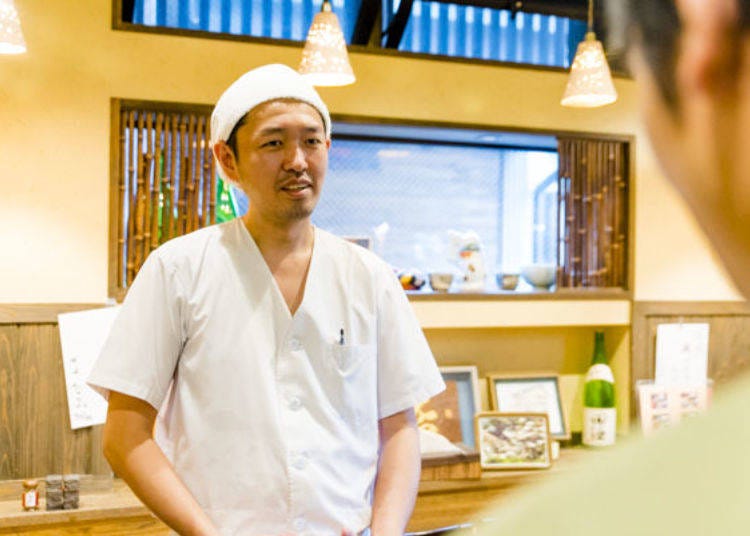
Mr. Fujikake: “I don’t know for sure, but I heard that himokawa udon started being served in the 4th generation when my grandmother got married. That must have been more than 70 years ago for sure.”
He also tells us of another theory as to how himokawa udon got its name, different from the origin of Imokawa.
Mr. Fujikake: Kiryu was a weaving town, right? In the past, dyed kimono belts were washed in the river, and there’s a theory that the expression ‘obikawa’ (belt river) turned into ‘himokawa’ over time.”
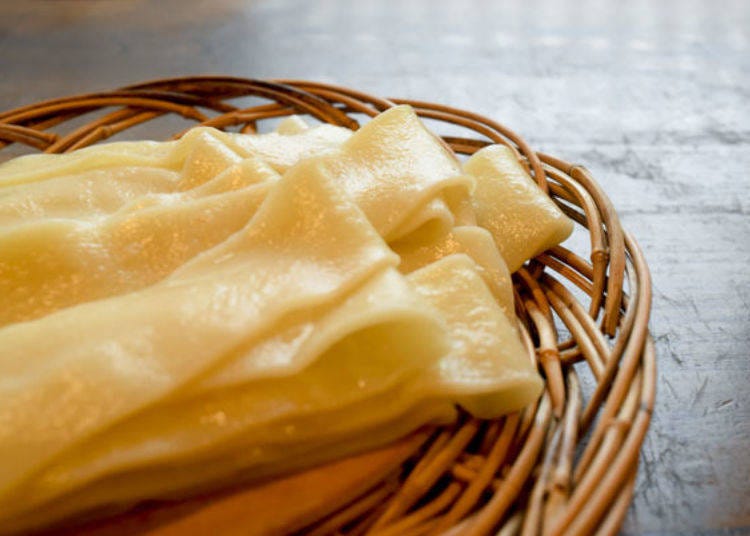
Lunchtime during weekends is often crowded with families and seniors. Fujiya Honten also sometimes closes early when all the noodles are gone, so we highly recommend coming early. Only lunch is offered on weekdays, so keep that in mind if you plan on visiting!
-
Fujiya Honten藤屋本店
- Address 1 Chome-6-35 Honchō, Kiryū-shi, Gunma-ken 376-0031
- Phone Number 0277-44-3791
Hours: 11:30 a.m. – 2:30 p.m. last order, 5:30 p.m. – 8:30 p.m. last order
*Only lunch from Tuesday to Thursday. Closes when out of stock.
Closed: Mondays (open in case of national holidays, closed on the following Tuesday), every 4th Tuesday of the month
The unique texture, the exquisite mouthfeel—that’s himokawa udon, a gourmet experience you absolutely cannot miss out on!
We had an amazing time trying our way through different himokawa udon specialties while learning about the background and history of the local delight. Both Furukawa and Fujiya pampered our taste buds with exquisite dishes that were surprisingly different, ranging from 12cm width to 4cm width! We certainly hope that himokawa udon will further spread because we’ve found a new favorite dish!
For now, you can only eat himokawa udon in Gunma’s Kiryu area, Curious gourmets should definitely make the trip and discover the many local highlights, with the flavorful noodles being only one of them!
- Area
- Category
*Prices and options mentioned are subject to change.
*Unless stated otherwise, all prices include tax.
Popular Tours & Activitiess
Recommended places for you
-

Ueno Zoo (Ueno Zoological Gardens)
Zoos, Aquariums & Botanical Gardens
Ueno
-

Shinjuku Gyoen National Garden
Gardens
Shinjuku
-

FUMOTOYA Keiopurazahoteru
Udon & Soba
Shinjuku
-

Tsukiji Outer Market
Old Towns (Shitamachi)
Tsukiji
-

Kappabashi Street
Old Towns (Shitamachi)
Asakusa
-

Senso-ji Temple
Temples
Asakusa
-

New Seibu L00 Series Launching in 2026! What to See Along the Tokyo-Area Golden Route
by: Guest Contributor
-

Tokyo City Pass Upgrade: Harry Potter Studio Tour & Top Sights up to 85% Off
by: Guest Contributor
-

Enjoy Japan's Gorgeous Winter Lights! Ride the Romancecar to Shonan no Hoseki Illumination
by: Guest Contributor
-

The Best Japanese Food Representing 2025! 'Dish of the Year®' Annual Award Results Announced
-

Keisei × Keikyu 16-Temple Goshuin Tour: Discover Deeper Tokyo & Yokohama
by: Guest Contributor
-

A Travel Game Changer! Go Hands-Free Between Tokyo and Kyoto with LUGGAGE EXPRESS by JTB and JR Tokai
by: Guest Contributor
Inspiration for Accommodations
-

Enjoy Mt. Fuji from the Comfort of Your Room! Recommended Ryokan with Mt. Fuji View
-

Stay Near the Cherry Blossoms! Hotels for Cherry Blossom Viewing in Tokyo
-

Family-Friendly Hotels with Free Shuttle to Disneyland: Convenient Access for a Magical Stay
-

Top Ranked Hakone Hotels with Mt. Fuji View: Enjoy Stunning Scenery from Your Private Space
-

Convenient Tokyo Hotels with Airport Shuttle: Ideal for Families and Heavy Luggage
-

Stunning Tokyo Tower View Hotels: Enjoy Spectacular Scenery from Your Private Space
-

Convenient Asakusa Hotels with Kitchens: Ideal for Extended Family Visits
-

Experience Luxury: Hakone's 10 Best Five-Star Accommodations
-

Enjoy Mt. Fuji Autumn Leaves! Top Hotels Near the Popular Autumn Leaves Corridor
-

Experience Hakone Fall Foliage from Your Room with Stunning Views
-

Secrets to Shopping in Japan: Guide to Annual Sales in Japan & Where to Shop
by: Miyu Shimada
-

What to Pack for Japan: 8 Essential Things for a Hassle-Free Trip
-

Delicious Asakusa Restaurants: Century Old Local Favorites
-

Check Out These Top 3 Delectable Dishes at Tokyo's Incredibly Popular 24-Hour Fuji Soba Shop!
-

Tokyo Train Map: Your Essential Guide to Subways and Railways
-

Asakusa Dining Guide: 3 must-try soba shops in Asakusa!
- #best ramen tokyo
- #what to buy in ameyoko
- #what to bring to japan
- #new years in tokyo
- #best izakaya shinjuku
- #things to do tokyo
- #japanese nail trends
- #what to do in odaiba
- #onsen tattoo friendly tokyo
- #daiso
- #best sushi ginza
- #japanese convenience store snacks
- #best yakiniku shibuya
- #japanese fashion culture
- #best japanese soft drinks












